41 how to read food labels carbohydrates
How To Read Food and Beverage Labels - National Institute on Aging How to read the Nutrition Facts label, The U.S. Food and Drug Administration (FDA) requires a Nutrition Facts label on most packaged foods and beverages. At the top of the Nutrition Facts label, you will find the total number of servings in the container and the food or beverage's serving size. Food labels - NHS Most pre-packed foods have a nutrition label on the back or side of the packaging. These labels include information on energy in kilojoules (kJ) and kilocalories (kcal), usually referred to as calories. They also include information on fat, saturates (saturated fat), carbohydrate, sugars, protein and salt.
Added Sugars on the New Nutrition Facts Label | FDA - U.S. Food … 25/02/2022 · Labels on packages and containers of single-ingredient sugars and syrups such as table sugar, maple syrup, or honey will list the percent Daily Value for added sugars within the Nutrition Facts ...
/carb-counting-and-diabetes-5209223_FINAL-9796df35fa38420baec37a37c3c8347e.jpg)
How to read food labels carbohydrates
Food Labels | Nutrition.gov Food and Drug Administration (FDA) regulates the safety of food for humans and animals, including foods produced from genetically engineered (GE) plants, sometimes referred to as "genetically modified organisms" (GMOs). Find out more about the safety of GE plants, and how they are regulated here. Low Carb Guide to Understanding Nutrition Labels - Virta Health Sugar should be zero as often as possible (1-2g at most). Fiber is a carb and should be included in your total for the day (initially 30g or less). Again, pay attention to the serving size. Something might be low in carbs, but if you eat 3 or 4 servings, you can easily go over your daily limit. 7. Food Labels: Carbohydrates | Home & Garden Information Center The Daily Value (DV) for total carbohydrate is 300 grams (g) or 100% DV, based on a 2,000-calorie diet. This number combines several types of carbohydrates: dietary fiber, sugars and complex carbohydrates. Listed below total carbohydrate on the food label are the values for dietary fiber and sugars.
How to read food labels carbohydrates. Added Sugar - The Nutrition Source The average American adult, teenager, and child consumes about 17 teaspoons of added sugar a day, or about 270 calories. [1] While we sometimes add sugar or sweeteners like honey to food or beverages, most added sugar comes from processed and prepared foods.. The leading sources of added sugars in the U.S. diet are sugar-sweetened beverages, desserts, and sweet snacks … Reading Food Labels | ADA - American Diabetes Association The Nutrition Facts labels on foods are really the key to making the best choices. We'll cover the basics so that these labels make shopping easier for you. Get started, Understanding Carbs, You've heard it all. From carb-free to low-carb, to whole and empty carbs, it's hard to know what it all means. Learn more, Food & Blood Sugar, Reading Food Labels for Carbohydrates - dummies To find the amount of carbohydrates in your foods, follow these steps: Look for the line that reads "Total Carbohydrate" on the label. The value on this line will tell you how many grams of carbohydrates are in one serving of the food. Check the number of servings per container to see if your package has one or more servings. Reading food labels: Tips if you have diabetes - Mayo Clinic A sugar-free label means that one serving has less than 0.5 grams of sugar. When you're choosing between standard products and their sugar-free counterparts, compare the food labels. If the sugar-free product has noticeably fewer carbohydrates, the sugar-free product might be the better choice.
How to Read a Food Label to Make Sure It's Keto in 3 Easy Steps How to calculate net carbs, Subtract Dietary Fiber and Sugar Alcohols (if any) from the Total Carbohydrate. *Total Carbohydrate minus Dietary Fiber, minus Sugar Alcohol (if any) = Net Carbs, Total Carbohydrate ( 4 grams) - Dietary Fiber ( 1 gram) = 3 gram s Net Carbs, PDF Read the Food Label for Carbohydrates - National Institutes of Health Read the Food Label for Carbohydrates, Food labels help you choose foods that are lower in calories and in carbohydrates and sweeteners. Here is a food label for a 12-ounce regular soda. The label provides lots of useful information. 1. Serving Size and Number of Servings, The serving size is 12 ounces. There's 1 serving in this container. 2. Carb vs. Sugar: How to understand nutrition labels - The LOOP Blog Carbohydrates are actually comprised of three nutrients: carbohydrates, fiber, and sugar. You may, and will see, foods that are very low in "sugar" but high in carbohydrate. Example 1, Let's look at a popular unflavored old fashioned oats label. Here we see that the total sugar is 1 gram. Looks great right? This item is practically sugar free! › en › healthy-livingUnderstanding Ingredients on Food Labels | American Heart ... Mar 06, 2017 · There are many terms used for sugar on food labels. You might see sugar listed as the fourth ingredient in a product and think it’s not so bad. But sugar can also be listed as high-fructose corn syrup or corn syrup, agave nectar, barley malt syrup or dehydrated cane juice, to name just a few. Read more about sugar and sweeteners.
› food-labelsFood Labels | Nutrition.gov Food and Drug Administration (FDA) regulates the safety of food for humans and animals, including foods produced from genetically engineered (GE) plants, sometimes referred to as "genetically modified organisms" (GMOs). Find out more about the safety of GE plants, and how they are regulated here. Food energy - Wikipedia Food energy is chemical energy that animals (including humans) derive from their food to sustain their metabolism, including their muscular activity.. Most animals derive most of their energy from aerobic respiration, namely combining the carbohydrates, fats, and proteins with oxygen from air or dissolved in water. Other smaller components of the diet, such as organic … Food Labels | CDC - Centers for Disease Control and Prevention If you eat the whole thing, you are eating 8 times the amount of calories, carbs, fat, etc., shown on the label. Total Carbohydrate shows you types of carbs in the food, including sugar and fiber. Choose foods with more fiber, vitamins, and minerals. Choose foods with lower calories, saturated fat, sodium, and added sugars. Avoid trans fat. How to read and understand a nutrition label - CNET Bold text vs. indented text. Bold text on a nutrition label will give you a top-level overview of the nutritional values, and the indented text beneath that breaks it down further. So "Total Fat ...
How to Understand and Use the Nutrition Facts Label | FDA - U.S. Food … 25/02/2022 · People look at food labels for a variety of reasons. But whatever the reason, many consumers would like to know how to use this information more effectively and easily.
How to Understand and Use the Nutrition Facts Label | FDA In the sample label, one serving of lasagna equals 1 cup. If you ate two cups, you would be consuming two servings. That is two times the calories and nutrients shown in the sample label, so you...
dtc.ucsf.edu › living-with-diabetes › diet-andCounting Sugar Alcohols :: Diabetes Education Online When counting carbohydrates for products made with sugar alcohols, subtract half of the grams of sugar alcohol listed on the food label from the total grams of carbohydrate. Remember that because sugar alcohols are harder for your body to digest, eating too many sugar alcohols may cause digestive complaints like gas, cramping and diarrhea.
How To Figure Out The Carbs On Nutrition Labels You might see mannitol, sorbitol, xylitol, erythritol, and others on the ingredients label. If the package says the product is "sugar-free" or has "no sugar added" it must list the sugar alcohols in the ingredients. If more than one type of sugar alcohol is listed, there must be a line for sugar alcohol grams on the nutrition label.
How to Read Nutrition Labels: Fat Content, Carbs & What To Look For Total Carbohydrate, The Nutrition Facts label lists three requirements for carbohydrates: Total Carbohydrates, Dietary Fiber, and Total Sugars. This section of the label is where you'll see if a product has any added sugar (a low-carb and general dietary no-no!) as well if the product uses Sugar Alcohols to add sweetness.
› article › 363276-food-groupsFood Groups for Carbohydrates, Proteins, Fats, Vitamins and ... Apr 02, 2020 · According to the National Center for Health Research (NCHR), the USDA recently replaced the food pyramid that was introduced years ago. Instead of the pyramid shape — which the NCHR says was criticized for confusing consumers — the new "ChooseMyPlate" recommendation contains five food groups of unequal sections, which include a hearty mix of carbohydrates (fruits and vegetables), proteins ...
How to read food labels | healthdirect Sugar: Sugar is a type of carbohydrate. It is better to choose healthier carbohydrates and to limit foods that are high in added sugars. Fibre: High fibre foods such as wholegrain bread and cereals improve digestion and help you to feel full. Sodium: This tells you how much salt the product contains. Eating too much salt is linked to high blood pressure and can lead to heart disease, …
This Is How to Read a Nutrition Facts Label on the Keto Diet 1 gram of carbohydrate = 4 calories (4 units of energy) 1 gram of fat = 9 calories (9 units of energy) You don't have to memorize these values, but simply keep in mind that calories are the sum total energy of the protein, carbs, and fats found in food, and they strongly influence whether you lose, maintain, or gain weight.
The Basics of the Nutrition Facts Label - Academy of Nutrition and ... 04/03/2022 · Use the percent Daily Values (DV) to help evaluate how a particular food fits into your daily meal plan. Percent DV are for the entire day, not just one meal or snack. Daily Values are average levels of nutrients based on a person who eats 2,000 calories a day. A food item with a 5% DV of fat provides 5% of the total fat that a person who needs ...
Understanding Food Labels | The Nutrition Source | Harvard T.H. All FOP labels in the U.S. are voluntary, which allows food manufacturers to highlight or hide the nutrition information they choose to help promote or preserve sales. If warning labels became mandatory, as public health advocates propose, the pressure on manufacturers would increase to change certain products to improve their nutritional quality.
How to Read the New Food Label - The Johns Hopkins Patient Guide to ... The percent daily value (%DV) can be used as a quick guide to the food label. Try the 5/20 rule when reading a label. Think about 5% or less as low for any nutrient and 20% or more is high for any nutrient. The %DV is a great way to compare food products if the serving size is the same. Fiber is the nutrient on the label that you want to aim ...
› how-to-read-food-labelsHow to read food labels | healthdirect Energy: A kilojoule is a measure of energy. To lose weight, you need to eat and drink fewer kilojoules (kJ) than you use. You should limit your intake of discretionary or junk foods — i.e. those that have more than 600kJ per serve.
dtc.ucsf.edu › learning-to-read-labelsLearning To Read Labels :: Diabetes Education Online On a nutrition food label, subtract the fiber from the total carbohydrate amount. When you read food labels, the grams of sugar are already included in the total carbohydrate amount, so you do not need to count this sugar amount separately. The grams of sugar listed include both natural sugars, from fruit or milk, and added sugars.
Is it Keto? How To Read Food Labels - 3 Easy Steps Serving Size (highlighted in red above): if you are counting carbs then you need to know how much of the food item will have the number of carbs, fiber, protein, etc that is shown on the label. Start by looking at the serving size to see what makes up a serving size. In this case 1 cup of this item is a serving size.
How to Read a Food Label | Atkins Here's what you should be aware of on a nutrition label: Serving size (if you have more than one serving, be sure to add in the carbs) Total carbohydrates expressed in grams, Amount of dietary fiber expressed in grams (subtract from total number of carbs to get the net carb count) Sugars expressed in grams,
How to Read Food Labels & Count Carbs | Allulose Keep a Check on Protein, Carbs and Sugars. As additional nutrients, most Americans get enough protein, but the Academy of Nutrition and Dietetics recommends consumers eat only moderate portions of lean meat, poultry, fish, eggs, low-fat milk, yogurt and cheese, along with beans, peanut butter and nuts. Carbohydrates can come from sugars ...
How to Read Food Labels | Your Low Carb Hub The below label shows there are 4.3g of carbs in a 15ml serving size which is equivalent to one tablespoon. 3.4g of this is sugar. There is 22.7g of sugar in 100ml, that's 5.6 teaspoons of sugar. The World Health Organisation (WHO) recommends no more than 5-10 teaspoons of added sugar in an entire day. Be aware of hidden sugars.
Understanding Food Nutrition Labels | American Heart Association Remember that the information shown in the label is based on a diet of 2,000 calories a day. You may need less or more than 2,000 calories depending upon your age, gender, activity level, and whether you're trying to lose, gain or maintain your weight. When the Nutrition Facts label says a food contains "0 g" of trans fat, but includes ...
Food Groups for Carbohydrates, Proteins, Fats, Vitamins 02/04/2020 · According to the National Center for Health Research (NCHR), the USDA recently replaced the food pyramid that was introduced years ago. Instead of the pyramid shape — which the NCHR says was criticized for confusing consumers — the new "ChooseMyPlate" recommendation contains five food groups of unequal sections, which include a hearty mix of …
How to Read Food Labels Without Being Tricked - Healthline A good rule of thumb is to scan the first three ingredients, as they make up the largest part of what you're eating. If the first ingredients include refined grains, a type of sugar, or...
How to Read Food Labels for Healthy Eating - Immuno Labs Sodium: 20 mg. Total Carbohydrates: 19g (8% of your daily value) Dietary Fiber: 0g. Total Sugars: 11g (18% of the daily value) Includes 9g Added Sugars. Protein 1g. Vitamin A 230mcg. Vitamin C 23mcg. Vitamin E 3.8 mcg.
How To Read Nutrition Labels (Like a Pro) - Ditch The Carbs Firstly you need to understand the difference between total and net carbs. TOTAL CARBS = sugars + starches +fibre, NET CARBS = total carbs - fibre, Carbohydrates will be on the nutrition label are often broken down into carbohydrates, sugars, starch, and fiber. However, each brand may display its nutritional contents differently.
How to read food labels: MedlinePlus Medical Encyclopedia This number helps determine how foods affect your weight. The total carbs (carbohydrates) are listed in bold letters to stand out and are measured in grams (g). Sugar, starch, and dietary fiber make up the total carbs on the label. Sugar is listed separately. All of these carbs except fiber can raise your blood sugar.
en.wikipedia.org › wiki › Food_energyFood energy - Wikipedia Many governments require food manufacturers to label the energy content of their products, to help consumers control their energy intake. To facilitate evaluation by consumers, food energy values (and other nutritional properties) in package labels or tables are often quoted for convenient amounts of the food, rather than per gram or kilogram; such as in "calories per serving" or "kcal per 100 ...
Learning To Read Labels :: Diabetes Education Online When you read food labels, the grams of sugar are already included in the total carbohydrate amount, so you do not need to count this sugar amount separately. The grams of sugar listed include both natural sugars, from fruit or milk, and added sugars. On a nutrition food label, the total carbohydrate includes the sugar.
How to Find Net Carbs: 9 Steps (with Pictures) - wikiHow Health Aim to have food with little or no added sugars. 2. Subtract the dietary fiber from the total carbohydrates. If you are eating an item with 26 grams (0.92 oz) of total carbohydrates and 5 grams (0.18 oz) of dietary fiber, you should subtract 5 from 26, leaving you with 21 grams (0.74 oz) (26 — 5 = 21). The dietary fiber should be conveniently ...
Counting Carbohydrates Using a Food Label - YouTube
Food Labels: Carbohydrates | Home & Garden Information Center The Daily Value (DV) for total carbohydrate is 300 grams (g) or 100% DV, based on a 2,000-calorie diet. This number combines several types of carbohydrates: dietary fiber, sugars and complex carbohydrates. Listed below total carbohydrate on the food label are the values for dietary fiber and sugars.
Low Carb Guide to Understanding Nutrition Labels - Virta Health Sugar should be zero as often as possible (1-2g at most). Fiber is a carb and should be included in your total for the day (initially 30g or less). Again, pay attention to the serving size. Something might be low in carbs, but if you eat 3 or 4 servings, you can easily go over your daily limit. 7.
Food Labels | Nutrition.gov Food and Drug Administration (FDA) regulates the safety of food for humans and animals, including foods produced from genetically engineered (GE) plants, sometimes referred to as "genetically modified organisms" (GMOs). Find out more about the safety of GE plants, and how they are regulated here.
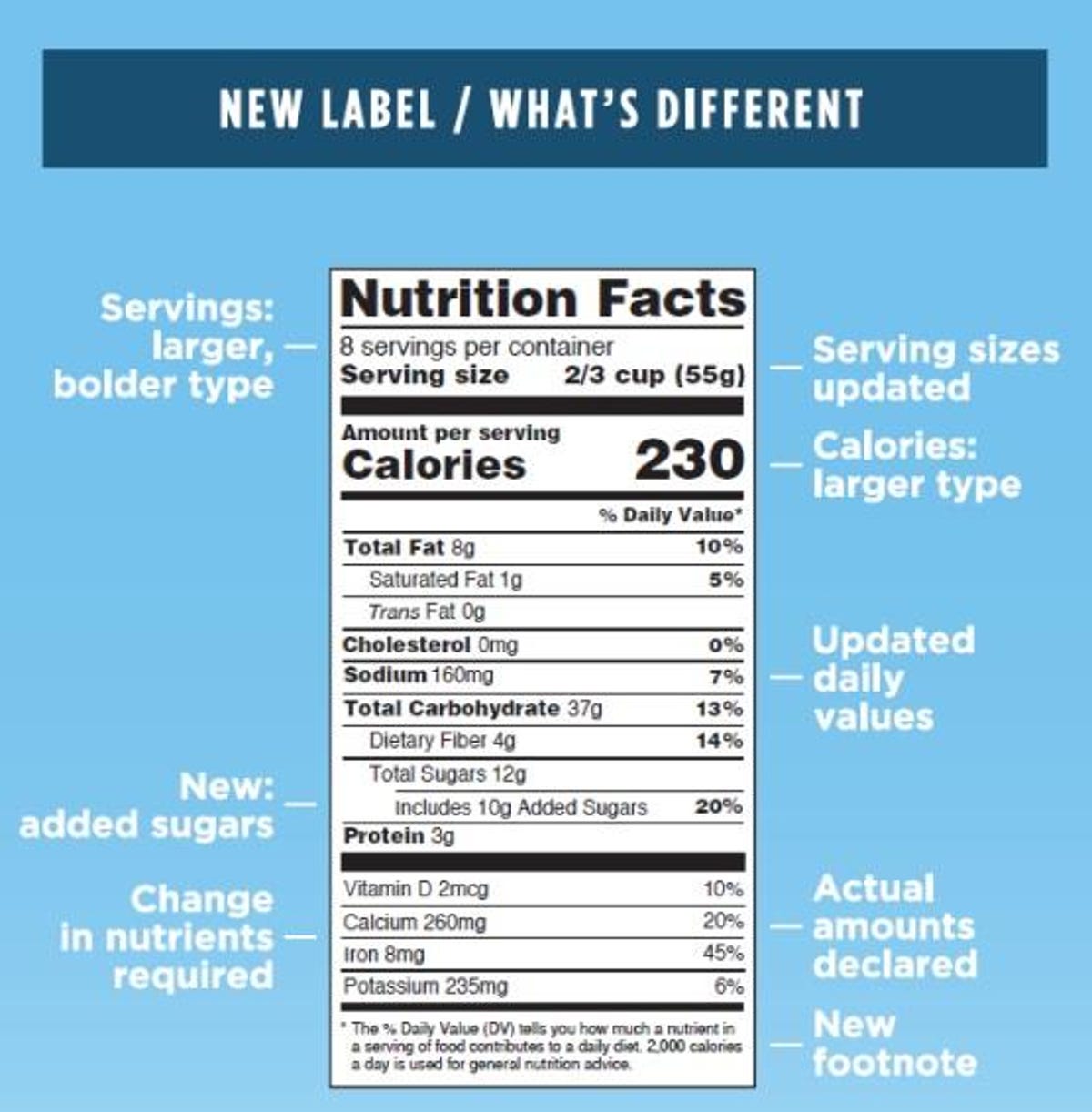
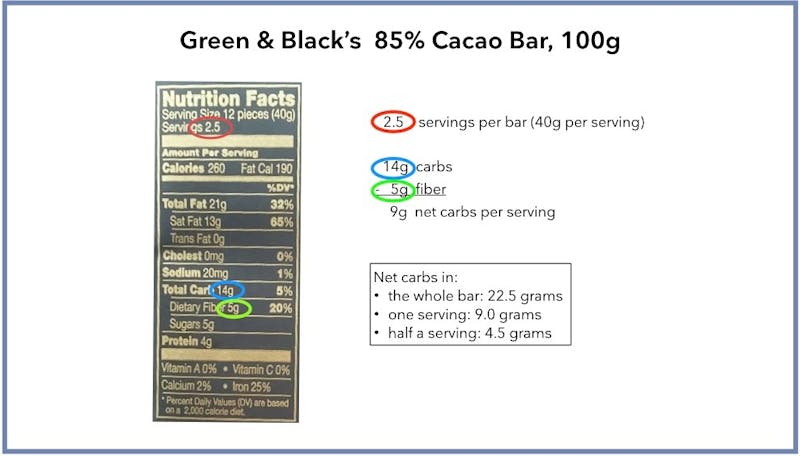
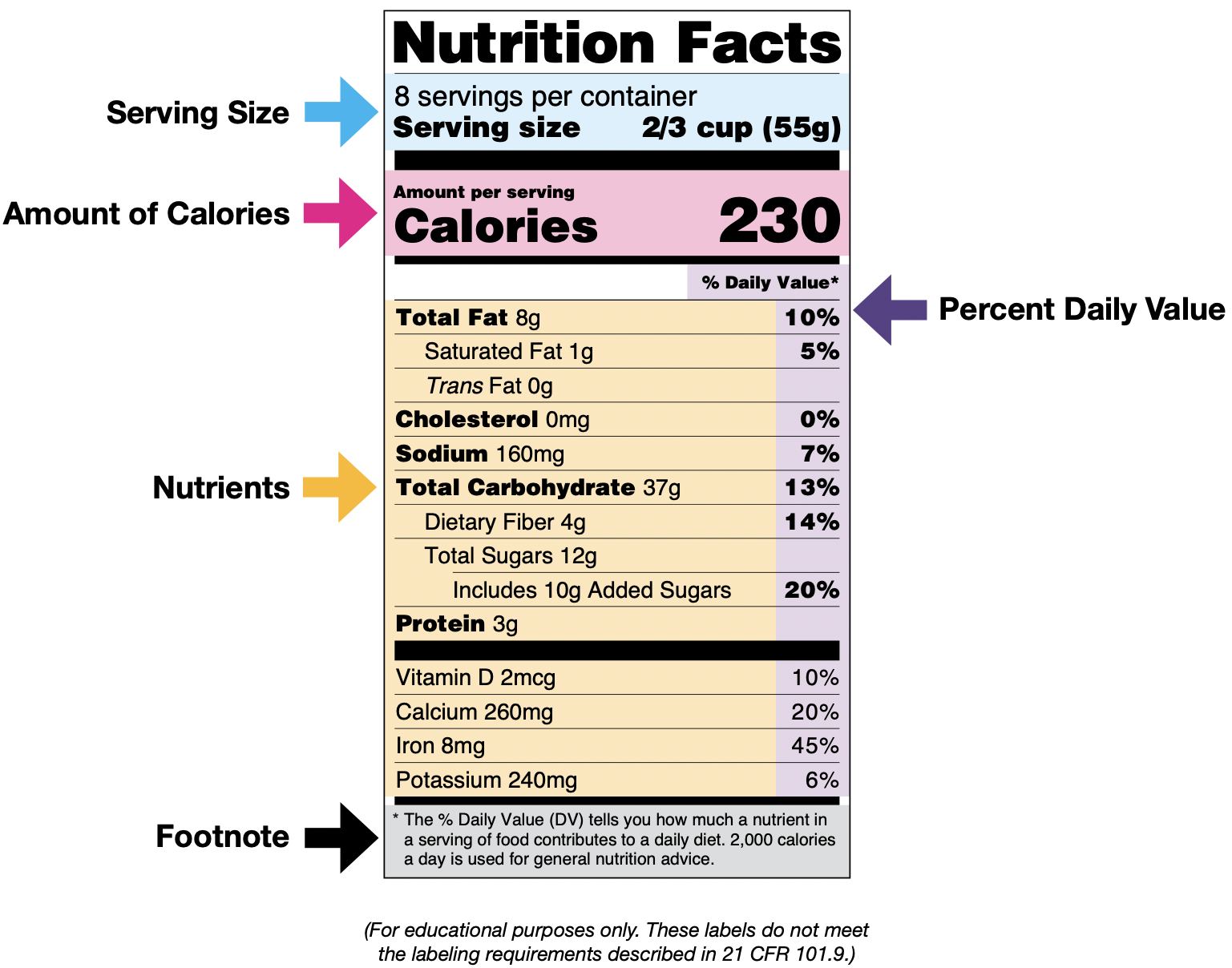






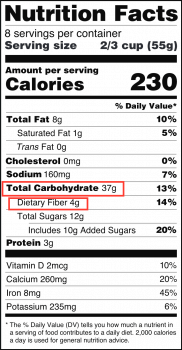

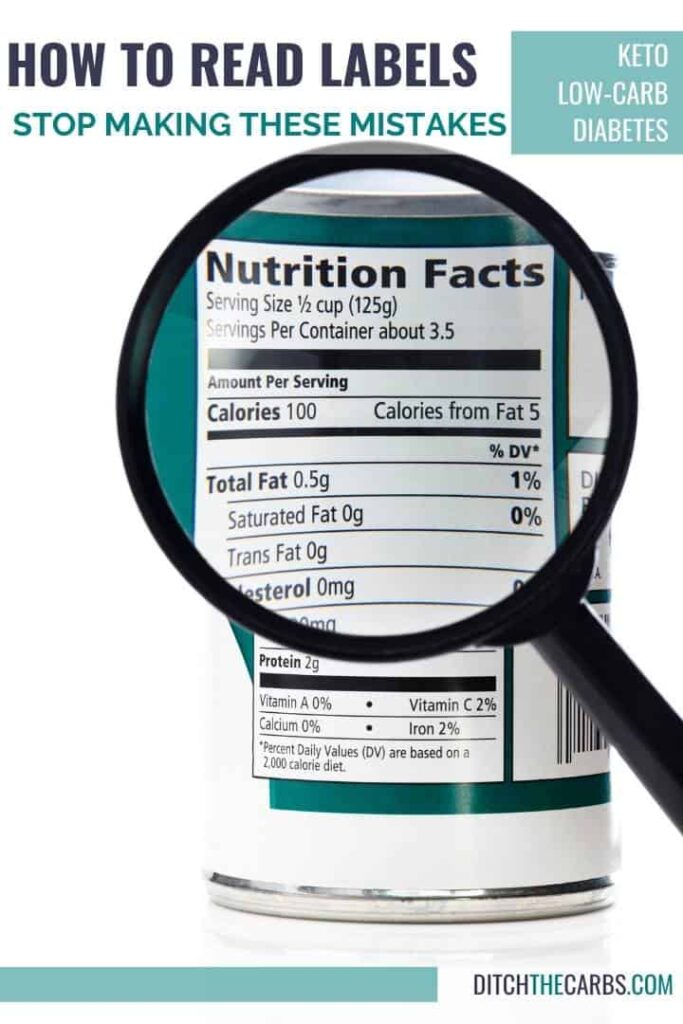


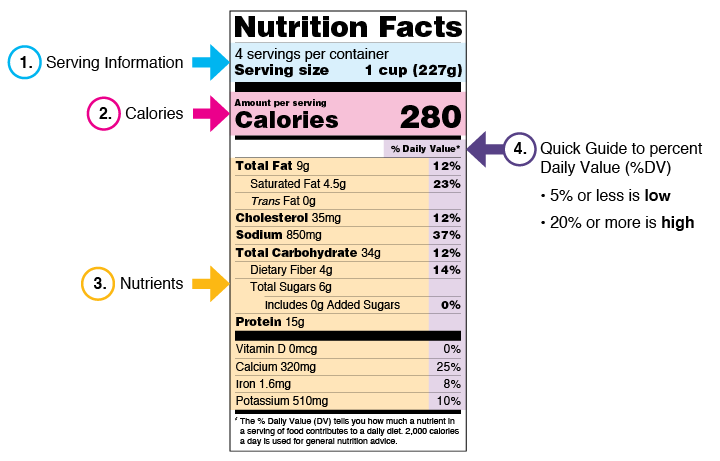



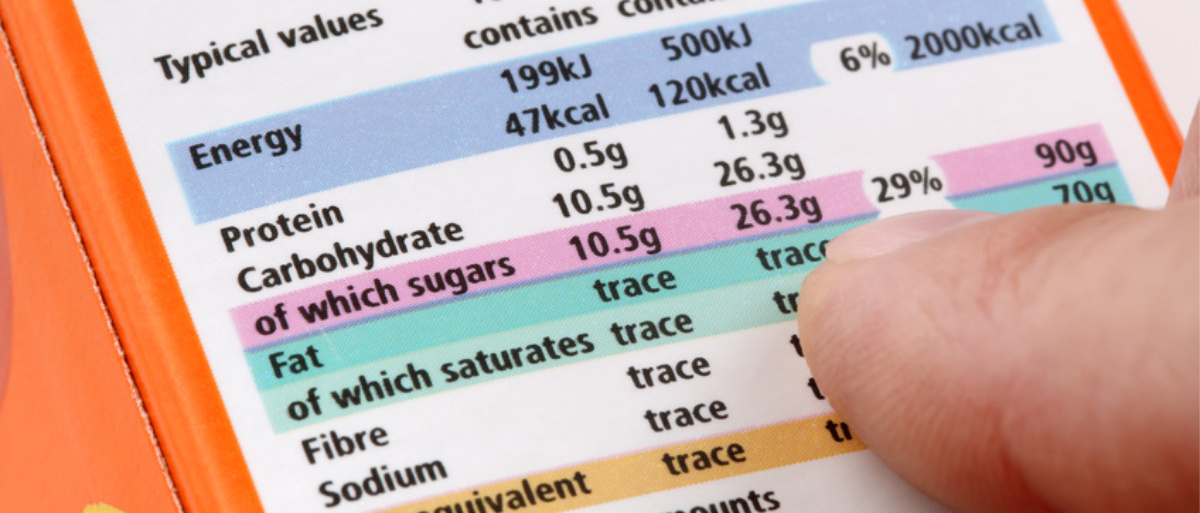
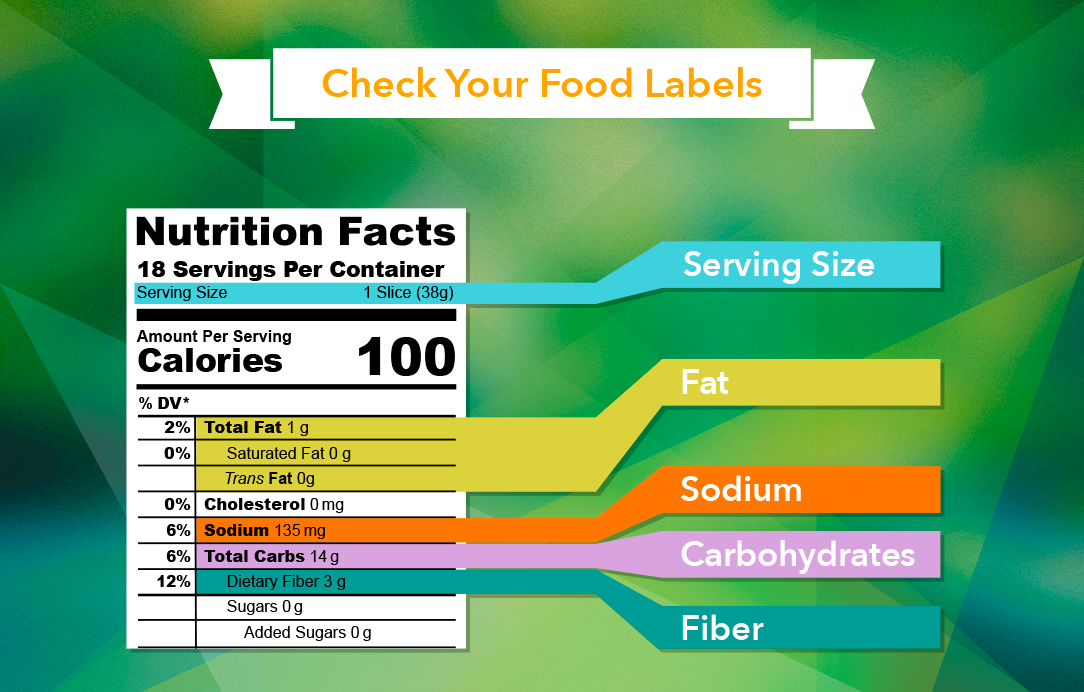
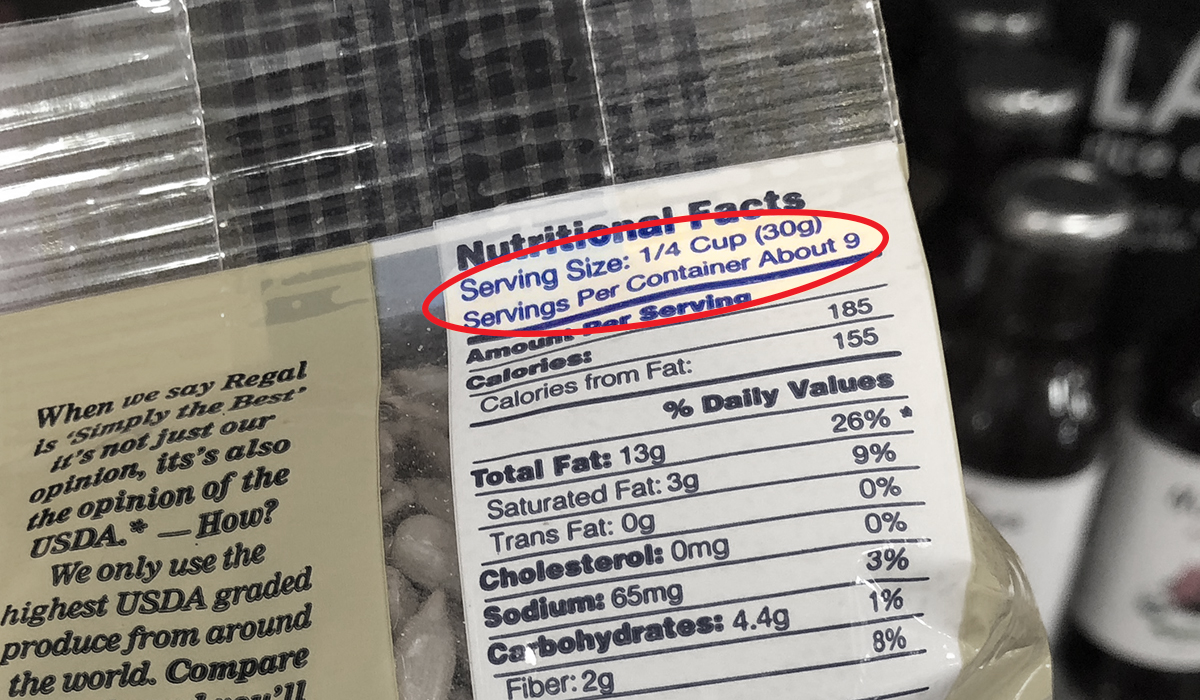
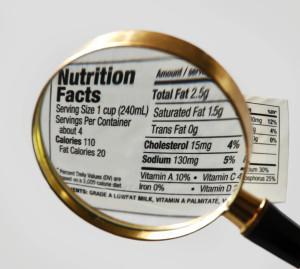

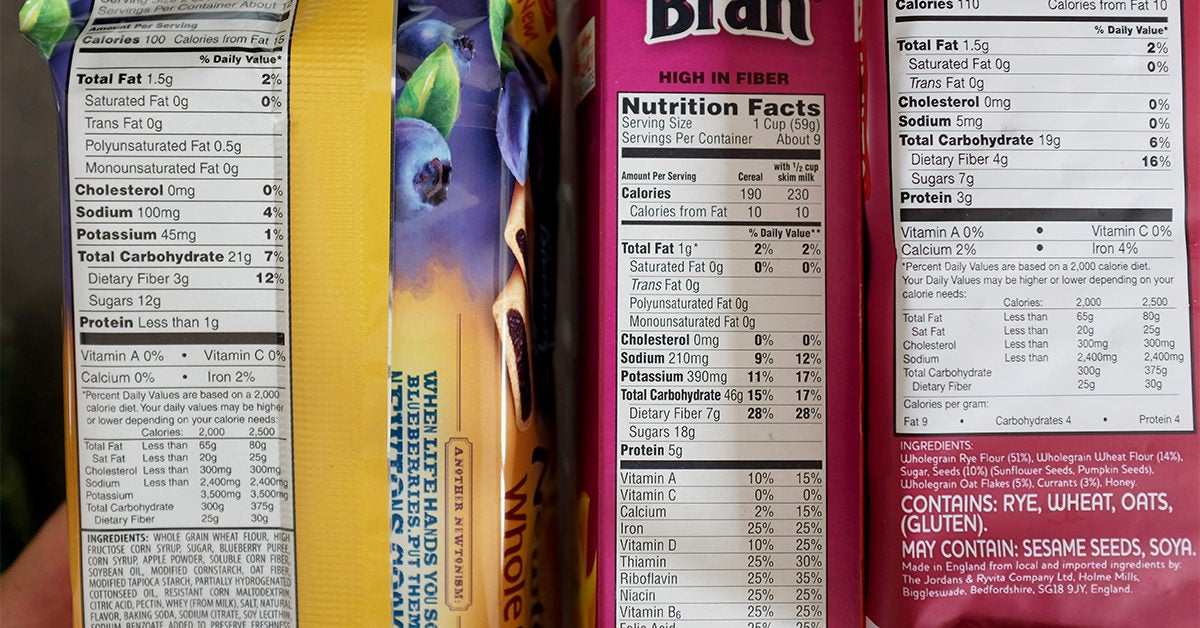



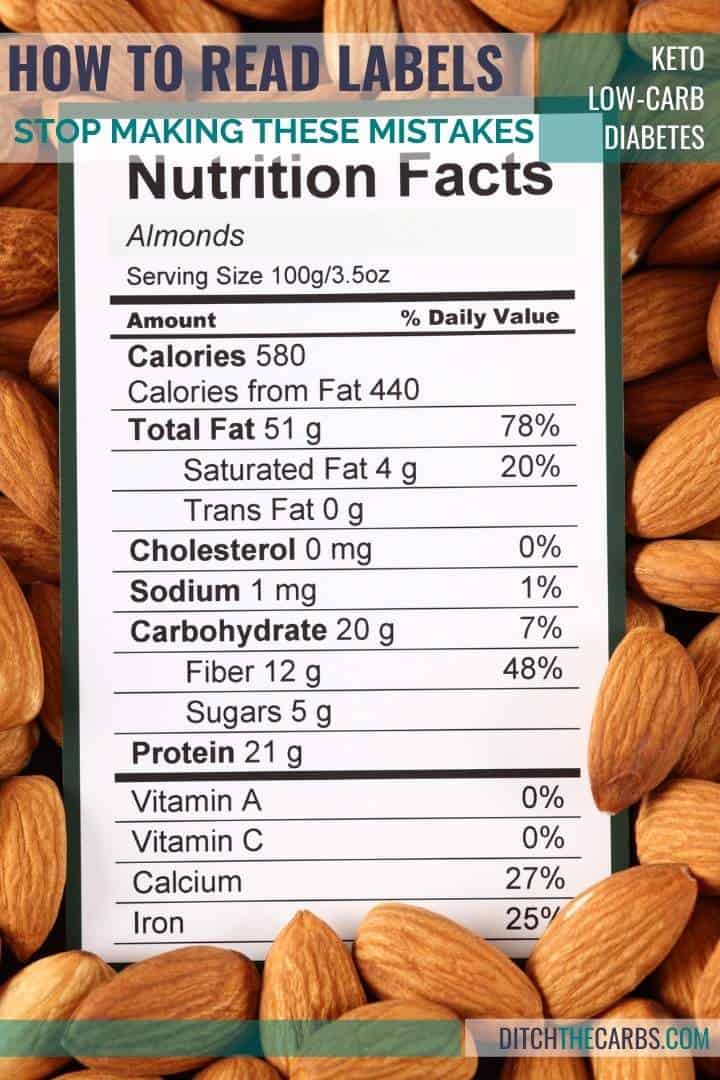
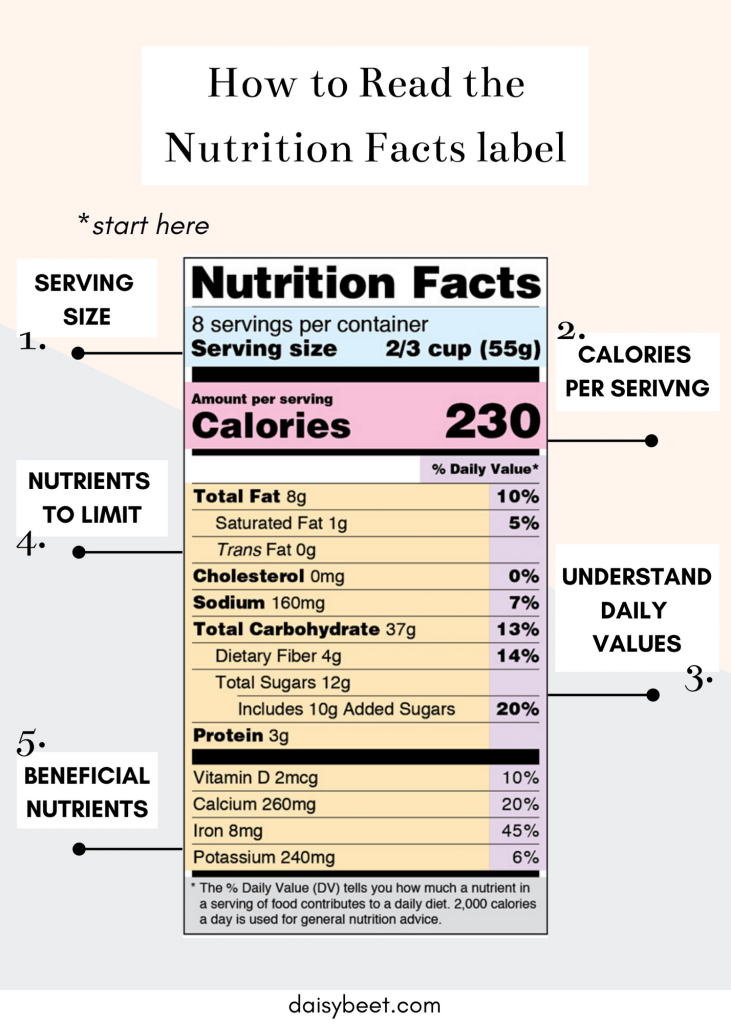
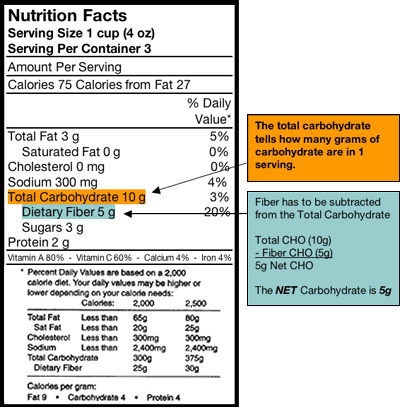
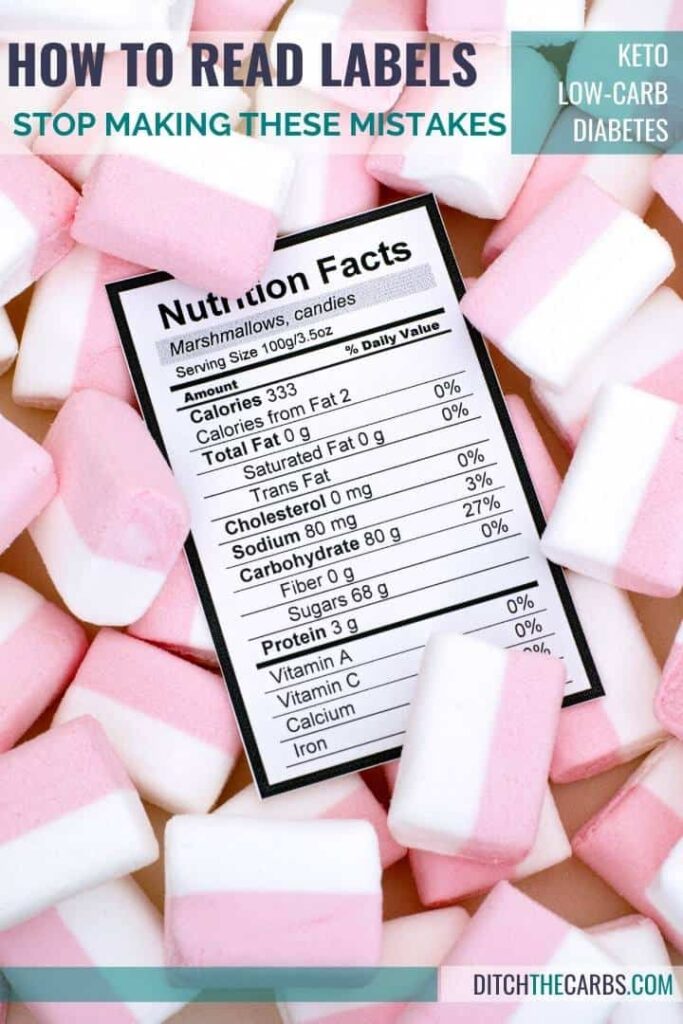

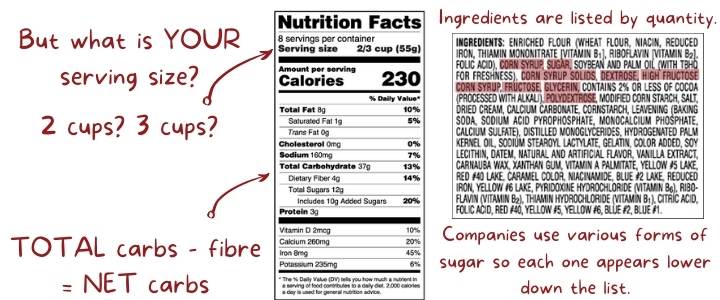
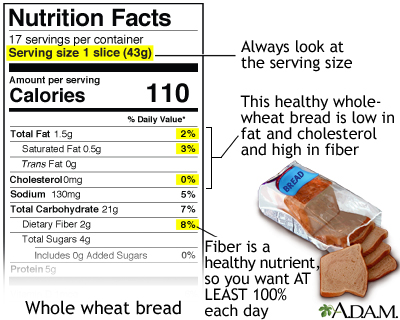
/Untitled-design-1--5755c3703df78c9b46903dab.jpg)
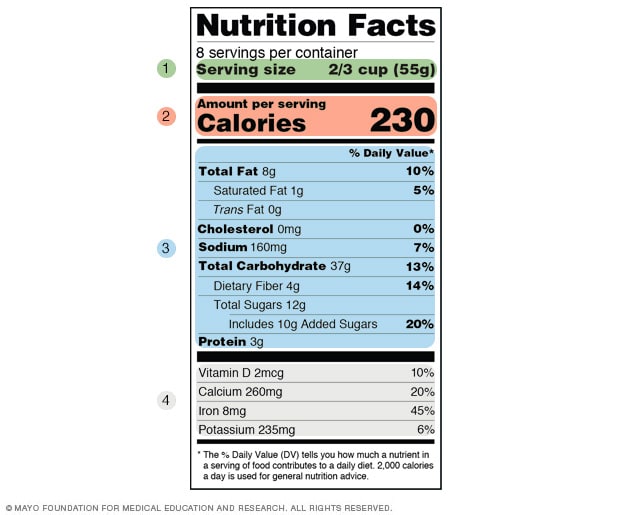
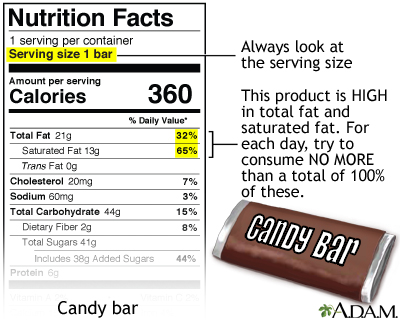
Post a Comment for "41 how to read food labels carbohydrates"